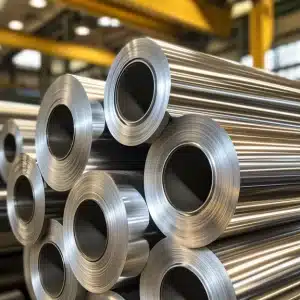
Why Acoustic Emission Monitoring Matters in Pressure Testing
In pressure vessel fabrication and a wide range of industrial applications, ensuring structural integrity during pressurization is absolutely critical. Acoustic emission monitoring offers a powerful, real-time solution for detecting internal flaws as they form under load. Unlike conventional non-destructive testing (NDT) methods that typically identify damage only after it has occurred, acoustic emission monitoring enables continuous observation of structural behavior throughout the pressurization process. This proactive approach makes acoustic emission monitoring especially effective at identifying emerging flaws—such as crack initiation, weld defects, or material fatigue—before they evolve into critical failures. By capturing stress-induced acoustic signals as they happen, acoustic emission monitoring delivers immediate insights into the condition of the vessel, pipe, or component under test. This makes it an ideal technique for both pre-service pressure testing and in-service inspections, where early detection and real-time feedback are essential to maintaining safety, ensuring regulatory compliance, and avoiding costly failures in the field.
What Is Acoustic Emission Monitoring?
Definition and Overview
Acoustic emission monitoring is a highly effective non-destructive testing (NDT) method that detects stress-induced sound waves generated within a material under mechanical load. These high-frequency acoustic signals are produced when microscopic events—such as crack initiation or propagation, fiber breakage, or internal structural shifts—occur within the material. Acoustic emission monitoring captures these emissions in real time, making it especially valuable during pressure increases when structural vulnerabilities are most likely to be revealed. Unlike static inspection methods, acoustic emission monitoring continuously tracks these stress responses, providing a dynamic and immediate assessment of material integrity. This capability allows engineers and technicians to detect early signs of failure before they escalate, ensuring safer and more efficient pressure testing in industrial environments.
How AE Detects Structural Stress
Acoustic emission monitoring systems use piezoelectric sensors placed directly on the surface of a pressure vessel, pipeline, or other critical structure. As internal stress increases during pressurization, these sensors detect transient sound waves generated by microscopic structural changes such as crack formation, weld shifts, or material deformation. Acoustic emission monitoring captures these high-frequency signals in real time, providing detailed data on when, where, and how intense each emission event is. This continuous feedback enables technicians to accurately pinpoint potential failure points as they develop, making acoustic emission monitoring an essential tool for proactive integrity assessment and real-time decision-making during pressure testing.
AE vs. Other NDT Methods
Unlike traditional non-destructive testing (NDT) techniques such as ultrasonic testing or radiography, acoustic emission monitoring does not rely on capturing a static image of a structure. Instead, acoustic emission monitoring continuously tracks dynamic structural behavior, detecting flaws as they emerge in real time during testing. This real-time monitoring capability allows acoustic emission monitoring to identify active issues—such as crack growth, material fatigue, or weld stress—under actual loading conditions. As a result, acoustic emission monitoring is ideal for evaluating structural performance under operational stress, providing insights not available through static inspection methods performed at rest.
Ideal for Real-Time Monitoring
Because AE works continuously during pressurization, it allows technicians to immediately spot and react to structural changes, potentially stopping a test before a failure occurs. This real-time capability adds a proactive layer of safety and quality assurance.
The Role of AE in Pressure Testing
Validating Vessel Integrity
Pressure testing is essential to verify that a pressure vessel or pipeline can handle its intended loads. AE enhances this process by detecting emissions triggered by flaws or stress concentrations—well before they cause leaks or ruptures.
Early Failure Detection
AE is especially valuable for identifying the onset of:
- Crack formation or growth
- Weld defects under pressure
Internal corrosion or thinning - Delamination or structural shifting
These emissions are early indicators of failure, offering the chance to take corrective action before damage becomes critical.
Continuous Monitoring vs. Periodic Inspection
Traditional inspections occur before or after a pressure test, giving a snapshot in time. AE offers continuous monitoring throughout the test, enabling dynamic assessment and real-time alerts.
Advantages of Acoustic Emission Monitoring
Real-Time Structural Feedback
AE systems provide a continuous stream of data, offering immediate insight into how a structure reacts to pressure. This allows teams to monitor structural health moment by moment during testing.
High Sensitivity to Active Flaws
AE is particularly sensitive to dynamic changes, which makes it highly effective at detecting:
- Crack propagation
- Corrosion-related activity
- Microstructural deformation
- Weld anomalies
Reduced Downtime and Testing Repetition
Because AE detects real-time flaws without disassembly, the need for repeated tests is reduced. It speeds up the inspection process while increasing reliability.
Cost-Effective for Large-Scale Inspections
AE is ideal for inspecting multiple areas of large vessels or systems in a single setup, making it time-efficient and economical—especially in manufacturing or field-service environments.
Industry Compliance
AE is aligned with several standards and recommended practices, including:
- ASME Section V
- API 579
- ISO 22096
Using AE helps maintain compliance while enhancing documentation and traceability.
Applications in Pressure Vessel Manufacturing
Pre-Service Testing
Before putting a new vessel into service, AE is used during pressure testing to validate weld quality and material integrity under load.
In-Service Monitoring
For vessels already in use, AE can be deployed to assess aging infrastructure without halting operations or cutting into the vessel.
Weld Quality Inspection
Since welds are often the weakest link, AE can pinpoint flaws or fatigue near or within welded joints—providing valuable feedback during fabrication.
Skid Packages and Prefabricated Spools
Compact, high-pressure systems like skid-mounted units and prefabricated spools benefit from AE’s targeted, sensor-based monitoring—ensuring every part meets service demands.
Enhancing Pressure Testing with Acoustic Emission Monitoring
Acoustic emission monitoring is transforming how pressure tests are conducted in the manufacturing and maintenance of pressure vessels, spools, and skid packages. By offering real-time, non-invasive insight into structural behavior under load, this method goes beyond traditional NDT by detecting flaws as they form—not just after they appear.
Whether for pre-service validation or in-service inspection, acoustic emission monitoring ensures a higher level of safety, reliability, and compliance. It reduces downtime, minimizes risk, and provides critical data when it matters most—during the test itself.
In a world where structural integrity is non-negotiable, acoustic emission monitoring delivers the confidence and control needed to move forward with certainty.
Need a reliable partner?
Red River specializes in the design and manufacturing of pressure vessels. We also fabricate related items such as prefabricated spools and skid packages.
Reach out to us today and experience the Red River difference. Where American-made products and American Values come together, we care more.
Frequently Asked Questions
1. What is acoustic emission monitoring used for?
AE is used to detect structural defects in real time during stress conditions like pressure testing or load application.
2. How does AE differ from ultrasonic testing?
AE detects active flaws as they happen, while ultrasonic testing locates existing flaws through reflected sound waves.
3. Is acoustic emission monitoring safe for pressure vessels?
Yes, it’s non-destructive and provides a proactive approach to identifying failure points without damaging the vessel.
4. Can AE monitoring be used on all materials?
It works best on metals, composites, and pressure-containing components that emit stress waves under load.
5. What types of defects can AE detect?
AE identifies cracks, fiber breaks, corrosion-related activity, leaks, and other dynamic defects.
6. Is AE monitoring required by industry codes?
While not always mandatory, AE is recommended in some ASME, API, and ISO testing scenarios for enhanced safety.
7. How does Red River implement AE in pressure testing?
We use calibrated equipment, trained professionals, and code-aligned procedures to ensure every vessel’s safety.
Key Takeaways
- Acoustic emission monitoring offers live detection of structural changes during pressure tests.
- It helps prevent failure by identifying flaws early and minimizing downtime.
- AE supports code compliance while saving time and cost—especially for large or complex vessels.
Red River uses AE to ensure weld quality, structural reliability, and manufacturing excellence.
Related Blog Post

Marine-Grade vs Standard Stainless Steel

Pros and Cons of Vertical Integration

How to Dry Desiccant Properly and Regain Its Effectiveness

Why Do Gas Turbines Need Fuel Water Separator Vessels, Red River

How Does a Gas Turbine Fuel Water Separator Vessel Work
- Vessel Weld Radiographic Inspection Procedures
- Magnetic Testing Pressure Vessels: Ensuring Structural Integrity
- Statistical Process Control Welding in Manufacturing
- Phased-Array Ultrasonic Testing for Weld Inspection
- HAZ Hardness Profile Mapping in Welded Components
- Dye Penetrant Inspection (DPI) for Surface Crack Detection
